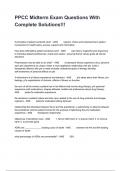PPCC Midterm Exam Questions With
Complete Solutions!!!
5 principles of patient centered care? - ANS respect, choice and empowerment, patient
involvement in health policy, access, support and information
How does IOM define patient-centered care? - ANS care that is respectful and responsive
to individual patient preferences, needs and values ; ensuring that pt values guide all clincial
decisions
Pharmacists must be able to do what? - ANS Understand illness experience of pt, perceive
each pt's experience as unique, foster a more egalitarian relationship with pts, build a
therapeutic alliance with pts to meet mutually understood goals of therapy develop
self-awareness of personal effects on pts
4 dimensions of pt illness experience and behavior - ANS pt's ideas about their illness, pt's
feelings, pt's expectations of clinician, effects of illness on function
the sum of all the events a patient has in his lifetime that involve drug therapy; pt's personal
experience with medications; shapes attitudes, beliefs and preferences about drug therapy -
ANS patient's medication experience
the decisions a patient makes and acts upon related to the use of drug products and dosage
regimens - ANS patient's medication taking behavior
relationship that develops between the pt and the practitioner; a partnership or alliance between
the practitioner and the patient formed for the purpose of optimizing the pt's medication
experience - ANS therapeutic relationship
Objectives of beneficent care - ANS 1. Not to inflict harm 2. to prevent harm 3. to remove
harm 4. to promote good
ADRs are _____________ leading cause of death - ANS between the 4th and 6th leading
causes of death
what percentage of ADRs are preventable? - ANS 50%
, normal part of care process that should be recognized and resolved; patient and time specific
circumstance that may not lead to optimal outcome from drug therapy - ANS Drug Therapy
Problem (DTP)
an outcome; an actual problem in the patient that is A. severe, dangerous, injurious or disabling
beyond the normal process of care AND B. is not correctable or requires significant additional
medical care to correct AND has a scientifically plausible relationship to "drug therapy" - ANS
Drug Related Morbidity (DRM)
what percentage of DRMs are preventable? - ANS 50%
Criteria for preventability of DRMs? - ANS recognizable (the DTP was recognizable),
foreseeable (the DRM was foreseeable), identifiable (cause of DTP was identifiable),
controllable (cause was controllable)
7 categories of DTPs - ANS Indication (unnecessary drug therapy and needs additional
therapy), effectiveness (ineffective drug or dosage too low), safey (adverse drug reaction,
dosage too high), adherence
Examples of Indication - unnecessary drug therapy - ANS duplicate therapy (multiple drugs
being used for condition that requires only a single drug); no medical indication requiring drug
thearpy, nondrug therapy more appropriate, addiction/recreational drug use, treating avoidble
adverse reaction (drug therapy is being taken to treat avoidable ADR associated with another
med)
Examples of Indication - needs additional therapy - ANS preventative therapy (required to
reduce risk of developing new condition), untreated conditions, synergistic therapy (medical
condition requires additional pharmacotherapy to attain synergistic or additive effects)
Examples of Effectiveness - ineffective drug - ANS more effective drug available, condition
refractory to drug, dosage form inappropriate, contraindication present, drug not indicated for
this condition
Examples of Effectiveness - dosage too low - ANS ineffective dose (too low), needs
additional monitoring, frequency inappropriate (too infrequent), incorrect aministration (not
appropriate route), drug interaction (interaction reduces amount of active drug available
resulting in lack of effectiveness), incorrect storage (stored incorrectly and lost potency),
duration inappropriate (too short)
Examples of Safety - Adverse drug reaction - ANS MUST RESULT IN ADR; undesirable
effect, unsafe drug (safer one required due to risk factors), drug interaction, incorrect
administration, allergic reaction, dosage increase/decrease too fast




